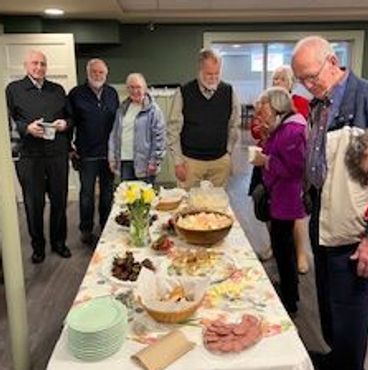About us

Who we are
Founded in 1799, the Barre Congregational Church has a long history of grappling with Jesus’ vision, message, and mission. In recent years, we have been identifying ourselves as “the church with the red doors.” The three sets of double red doors that grace the front of our meetinghouse are a constant reminder of our intention to practice our faith both internally and externally. Crossing the threshold of these doors reminds us that as Christians we attend to an inner journey and an outer journey. We believe both journeys are crucial to God’s vision of salvation, justice, and transformation for all creation. The prophet Micah writes, “And what does the Lord require of you but to do justice, and to love kindness, and to walk humbly with your God.”

What We Believe
As a member of the United Church of Christ, we are committed to discerning what is just and fair and to speaking words of justice to the wider community and ourselves. As a local church in a specific geographic location, regardless of which side of the red doors we find ourselves on, we extend kindness to all people believing they are created in God’s image, and are therefore deserving of God’s love, compassion, and acceptance.
We hold our doors and our hearts open to all people who seek deeper faith and a closer walk with Jesus Christ. We celebrate and affirm the sacred worth of all persons as unique individuals made in the image of God. Whatever your age, race, ethnicity, socioeconomic status, sexual orientation, gender identity or expression, marital status, or physical, cognitive, or emotional ability, we invite you to find a safe and nurturing spiritual home with us.

Our History
On November 14, 1799, the Barre Congregational Church was founded with twelve members. For seven years, Rev. James Hobart served both the Barre and Berlin congregations. In 1807, Rev. Palmer became the first resident minister. By then, the congregation had outgrown its log cabin and barn. A permanent church was built in 1804 in Gospel Village, next to Elmwood Cemetery.
As downtown Barre grew, members debated moving, eventually deciding to build a new church in 1840 at the current location. In 1887, the church was expanded with a new bell tower and stained glass windows after much debate. Two more expansions followed: in 1896, to house a new organ, and in 1999, to accommodate a growing congregation. Interior changes, including moving the organ and altering the chancel, sparked debate but reflected the church’s evolution.
This history, marked by both growth and controversy, is a testament to a congregation that has evolved from twelve people in a log cabin to a vibrant church that has served its community for 225 years.
Linda West
Church Historian
Sunday's at The Barre Congregational Church



.jpg/:/cr=t:11.54%25,l:11.54%25,w:76.92%25,h:76.92%25/rs=w:370,cg:true,m)




Barre Congregational Church
35 Church Street, Barre, VT 05641, US
